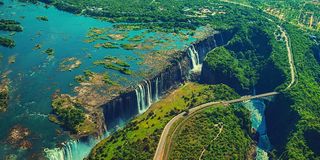How tourism towns can do better on carbon emissions

An aerial shot of Victoria Falls on the Zimbabwe/ Zambia border © Martin Mwaura
Tourism, like any other economic sector, contributes to climate change through carbon emissions. The sector has a lot to lose from unsustainable practices, though. And this can have a serious impact on local and national economies and people’s livelihoods.
Tourism is one of the most important economic sectors. It contributes an average of about 10 percent to global gross domestic product and employs millions of young people and women across the world.
The first global tourism carbon emissions estimate report was released in 2005. Since then, there’s been a growing demand for the industry to reduce its carbon footprint. Tourism contributes about 5 percent of the world’s greenhouse gas emissions. To address this, the World Travel and Tourism Council has committed to cutting back 50 percent of its emissions by 2035 relative to 2005 levels.
My study looked at one of Africa’s most famous tourism sites, Victoria Falls, also known as Mosi-oa-Tunya, located between Zambia and Zimbabwe. The study examined how the Victoria Falls town tourism industry contributed to greenhouse gas emissions and what the industry was doing to mitigate climate change.
I found that the main sources of carbon emissions were the hospitality, transport and attraction sectors. The findings show that there’s potential to reduce the site’s carbon footprint through improving operational efficiency and investigating in green technology.
These findings could also guide other tourism sites – such as Kruger National Park in South Africa, Kariba resort town in Zimbabwe and the Okavango Delta in Botswana – in their efforts to become more sustainable and more attractive to environmentally aware tourists.
Victoria Falls
Victoria Falls is a nature-based tourism resort. As such, it also positions itself as a destination that’s conscious of its environmental practice. This is its brand appeal. Victoria Falls is an important tourism site to Zimbabwe and the broader African tourism market given several business linkages.
Victoria Falls itself is a fragile ecosystem. It has felt the impact of climate change through severe fluctuations in water flow at the waterfalls.
More than 600,000 tourists visit this World Heritage Site annually from around the world.
The primary activities in the resort town include a visit to the waterfalls, walking trails in the Victoria Falls rain forest, bungee jumping, game drives, swimming, cultural activities, boat rides and helicopter rides over the waterfalls. The primary economic activity in the town is tourism and immigration services.
My study focused on tourism businesses’ operational activities that have a bearing on greenhouse gas emissions, including green purchasing practices, type of equipment used, type of energy used, fuel consumption and measures to save energy and water. I found that the accommodation establishments in the Victoria Falls area were constructed sustainably to avoid minimal environmental disruptions.
Carbon emissions
My research found that various activities add to the burden of carbon emissions throughout the tourism value chain in Victoria Falls resort town.
All of the 50 accommodation establishments that participated in the research indicated that their operations were mostly dependent on electricity – which is mostly produced from coal. Drivers of emissions include energy inefficient equipment such as geysers and air conditioners.
Most accommodation establishments had high water usage, which also adds to the environmental footprint of the hospitality industry.
One of the worst contributors to greenhouse gases in the town is the vehicle fleet of the attraction and travel sector. Activities such as helicopter rides add to this, as do a large old fleet of road transport and large SUVs. The aviation sector alone, linking Victoria Falls to the world, is the site’s biggest contributor of greenhouse gas emissions.
The study also found that despite some efforts to be sustainable – with a lot of resources used in the construction and design being local – the culture of green purchasing within the tourism sector had not reached the acceptable stage.
Green tourism
But the resort town has the potential to redefine itself as a green tourism destination. Cognisant of the impact of climate change on the destination and business prospects, a number of tourism businesses have started to follow green tourism practices.
Some of the establishments have started to reduce carbon emissions by adopting gas for cooking and investing in solar technology for heating and lighting. But the uptake of solar is still slow because the technology is expensive to install.
Other projects in the town include those aimed at offsetting carbon emissions by planting more trees, which store carbon. The main mitigating initiative was waste separation and recycling.
Given the current pace, the resort town is unlikely to meet the global emissions targets of reducing emissions by 40 percent by 2030 in line with the demands of the Paris Agreement and the 2030 Agenda for Sustainable Development Goals.
Going forward
Given the potential dangers associated with failing to reduce carbon emissions and climate change, Victoria Falls – and other tourism sites – needs strategic measures to help it onto a greener path.
Green building designs are one way of reducing environmental impact while still keeping tourists comfortable. With regard to transport, there’s a need to decongest the town through a rapid, efficient transport system and encourage bicycle usage to reduce emissions from road transport.
Climate financing and rebates on equipment aimed at transitioning to green tourism are imperative from government, banks and other financing agencies. This financial assistance is crucial given the negative impact of the COVID-19 pandemic on the tourism industry. A government led comprehensive policy is also needed to nudge more companies towards carbon neutral growth.




